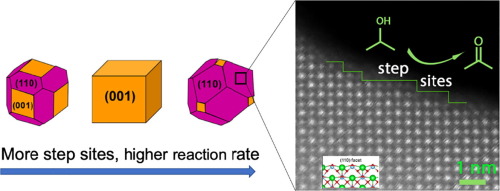Journal of Catalysis ( IF 6.5 ) Pub Date : 2020-02-27 , DOI: 10.1016/j.jcat.2020.02.014 Zhenghong Bao , Victor Fung , Felipe Polo-Garzon , Zachary D. Hood , Shaohong Cao , Miaofang Chi , Lei Bai , De-en Jiang , Zili Wu

|
Strontium titanate (SrTiO3) is an extensively investigated perovskite for various applications due to its optical, electrical and chemical properties. To gain an in-depth understanding of the active sites involved in heterogeneous catalysis over the broadly used SrTiO3 (STO), we studied a model reaction, isopropanol conversion, on three differently shape-controlled nanocrystals: cube, truncated cube and dodecahedra. SEM, XRD and XPS confirmed the morphology, phase and composition of STO shapes. Low energy ion scattering (LEIS) revealed the occurrence of surface reconstruction over STO shapes during O2 pretreatment at different temperatures. Based on the catalytic activities, scanning transmission electron microscopy images and density functional theory calculations, the step sites on STO derived from surface reconstruction were proposed to be the active sites for isopropanol conversion. This was further confirmed by steady state isotopic kinetic analysis (SSITKA) which demonstrated similar intrinsic turnover frequencies (TOFs) for the differently reconstructed STO shapes. It is concluded that the crystal facets impose an indirect effect on the catalysis of STO via controlling the degrees of surface reconstruction: the less stable STO (1 1 0) facet (dodecahedra) leads to more step sites after reconstruction and hence higher overall reaction rate than the more stable (1 0 0) facet (cube). This work highlights the important interplay between the crystal facet and surface reconstruction in controlling the nature and density of active sties and thus catalysis over complex oxides.
中文翻译:

SrTiO 3纳米晶体表面刻面与异丙醇转化重建之间的相互作用
钛酸锶(SrTiO 3)由于其光学,电学和化学性质而被广泛研究用于各种应用的钙钛矿。为了深入了解在广泛使用的SrTiO 3(STO)上进行多相催化的活性位点,我们研究了模型反应,异丙醇转化率,作用于三种不同形状控制的纳米晶体:立方体,截头立方体和十二面体。SEM,XRD和XPS证实了STO形状的形态,相和组成。低能离子散射(LEIS)揭示了O 2期间在STO形状上发生了表面重构在不同温度下进行预处理。基于催化活性,扫描透射电镜图像和密度泛函理论计算,提出了表面重构产生的STO上的阶梯位点是异丙醇转化的活性位点。稳态同位素动力学分析(SSITKA)进一步证实了这一点,该分析表明,不同重构的STO形状具有相似的固有转换频率(TOF)。结论是,通过控制表面重构的程度,晶面间接影响了STO的催化作用:稳定性较低的STO(1 1 0)面(十二面体)导致重构后出现更多的台阶部位,因此总体反应速率更高比更稳定的(1 0 0)构面(多维数据集)要好。











































 京公网安备 11010802027423号
京公网安备 11010802027423号